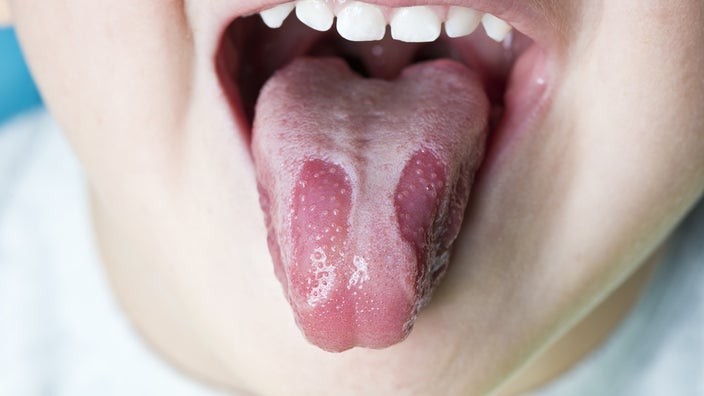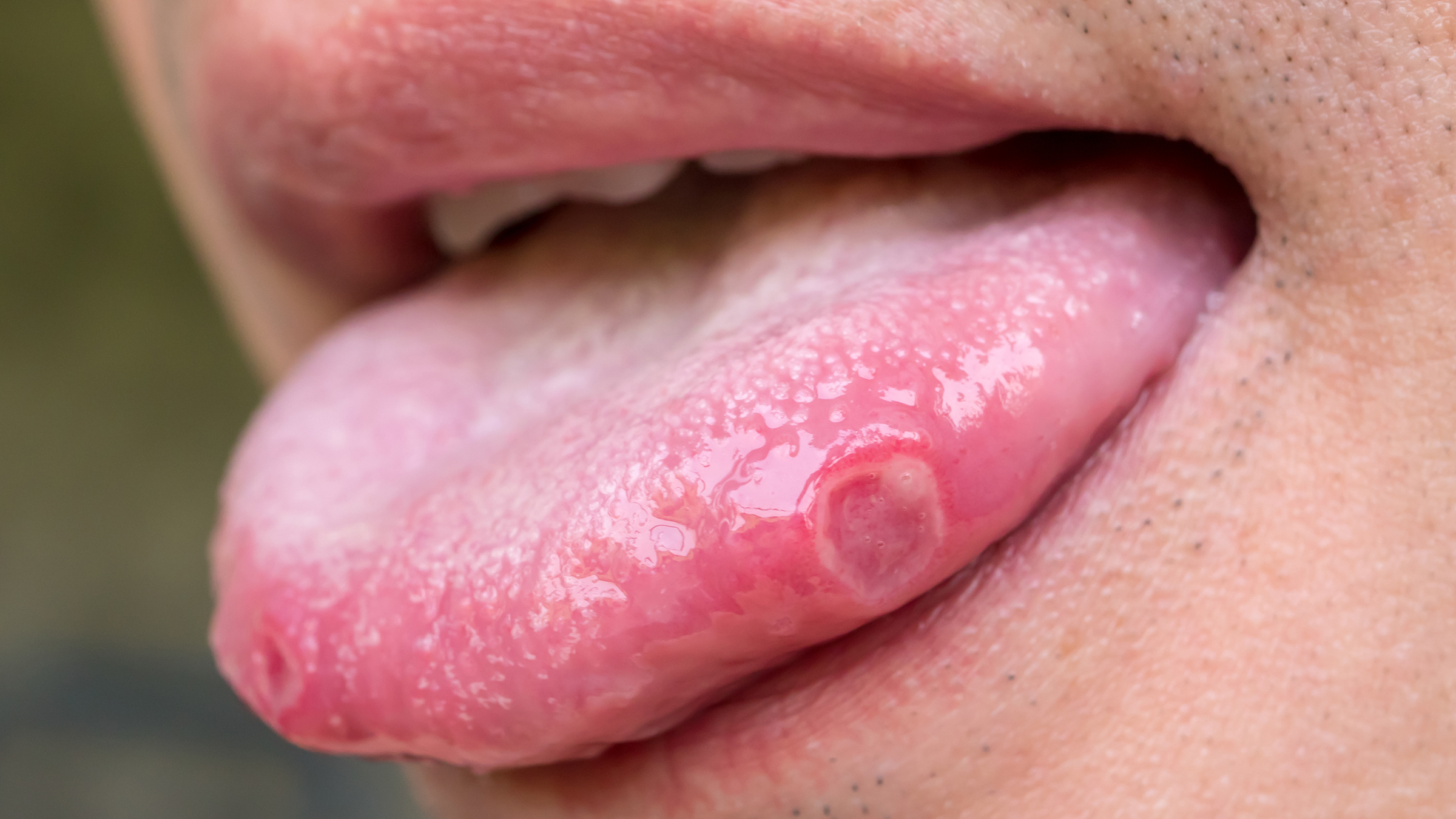
Does Your Tongue Look Weird? It Could Be Geographic Tongue
Key takeaways:
White and red swirls on your tongue are a sign of geographic tongue (benign migratory glossitis).
Tongue inflammation and damage to the tongue surface causes geographic tongue.
Though it may look (and sound) scary, geographic tongue isn’t usually bothersome and goes away on its own.

You might not spend a lot of time thinking about your tongue. But changes in your tongue’s appearance will probably stop you in your tracks. Geographic tongue, also called “benign migratory glossitis,” causes red patches on the tongue’s surface.
This condition has puzzled people for years, and its exact cause is still a mystery. But despite its strange appearance, geographic tongue is harmless. Let’s take a closer look at this unique tongue condition.
What does geographic tongue look like?
Geographic tongue has a very unique appearance.
People with a geographic tongue develop smooth, red patches over the top of their tongue. The patches can be different shapes and sizes. These patches are usually outlined with white wavy lines. This combination makes the tongue look like a map of another planet. That’s how the condition got the name “geographic tongue.”
People may also develop cracks or fissures over the surface of their tongue.
Here’s another eerie feature of geographic tongue: The patches and lines can move over time. Red patches may disappear after a few weeks, only to reappear in a different spot later on.
Even though it’s called geographic tongue, spots can also appear on the other parts of the mouth, including the:
Sides of the tongue
Inside part of the cheeks
Inside of the lips
Floor and roof of the mouth
Does geographic tongue cause any symptoms?
Even though a geographic tongue can look strange, it doesn’t usually cause any symptoms. Most people don’t even know they have it until they see it in the mirror.
Sometimes people experience symptoms, like:
Burning over the top of the tongue
Tongue sensitivity to hot, spicy, or sour food
A burning sensation in their mouth
Changes in taste (dysgeusia), which makes food taste metallic, sweet, or sour
WHAT TO READ NEXT
What causes geographic tongue?
Geographic tongue develops when there’s inflammation on the tongue's surface. This inflammation damages the filiform papillae.
The filiform papillae are the cone-shaped structures that give your tongue its textured look. When they’re damaged, you can see the lining of the tongue, underneath which looks red and smooth.
It’s not clear why people develop geographic tongue.
Geographic tongue may be related to:
Genetics: You’re more likely to develop geographic tongue if someone in your family has it too. There’s some evidence that people who are genetically more likely to develop psoriasis are more likely to develop geographic tongue.
Stress: Stress may increase your chances of developing geographic tongue. This includes physical, emotional, and mental stress.
Medications: There have been reports of people developing geographic tongue after taking birth control pills and certain types of cancer medications.
Vitamin deficiencies: Certain types of vitamin deficiencies have been linked to geographic tongue, including vitamin D, vitamin B6, vitamin B12, folic acid, iron, and zinc.
Age: Children and young adults are more likely to develop geographic tongue. While up to 15% of all children develop geographic tongue, less than 2% of adults over 30 experience it.
Can geographic tongue be a sign of another health condition?
Sometimes.
About 8% of people who develop geographic tongue have a Candida infection, like thrush. Some people also develop geographic tongue after mouth trauma from dental procedures or accidents. Medication reactions have also been linked to geographic tongue.
Geographic tongue has been linked to conditions, like:
Allergic rhinitis (hay fever)
Psoriasis
If you think you have geographic tongue, your dentist or healthcare provider can check to make sure you don’t have a Candida infection or signs of another medical condition.
Your provider can also confirm that your tongue changes are from geographic tongue and not another condition that can change your tongue’s appearance.
Can you treat geographic tongue?
It depends.
If you have a Candida infection, medications that fight off the infection can help clear up your geographic tongue. This might include oral medications or mouthwashes.
Keep in mind, even after your fungal infection is gone, it will take time for your tongue to go back to normal. That’s because the filiform papillae need to grow back. And this takes time.
If your geographic tongue is from another medical condition, starting treatment for that condition will bring down the inflammation on your tongue. This will let your tongue heal so that your filiform papillae can grow back.
But, if you’re like most people with a geographic tongue and you don’t know what’s causing it, there’s no way to quickly stop the inflammation. It can be frustrating, but the only option is a “wait-it-out” approach. The inflammation will go away on its own, your filiform papillae will grow back, and your tongue will look like its usual self again.
If your geographic tongue is causing burning, pain, or other symptoms, there are medicated mouthwashes that can help relieve your symptoms. Your healthcare provider or dentist can prescribe these mouthwashes for you.
It can also help to avoid things that can irritate your mouth, like:
Alcohol
Hot foods and drinks
Spicy or sour foods
Acidic fruits and beverages
Toothpastes with sodium lauryl sulfate
The bottom line
Geographic tongue is inflammation of the top of the tongue that causes damage to the filiform papillae. Geographic tongue looks like smooth, red patches surrounded by white, wavy lines. Geographic tongue isn’t harmful and doesn’t often cause any symptoms. It usually goes away on its own, but it can come back.
Sometimes, it can be a sign of a fungal infection or another medical condition. If you have tongue pain or burning, talk to your healthcare provider or dentist about starting treatment for geographic tongue.
References
Department of Oral & Maxillofacial Surgery. (2022). Geographic tongue. Royal Berkshire NHS Foundation Trust.
González-Álvarez, L., et al. (2018). Geographic tongue: Predisposing factors, diagnosis and treatment. A systematic review. Revista Clínica Española.
Humphries, K. (n.d.). Figure, geographic tongue. Contributed by Katherine Humphries. StatPearls.
Picciani, B. L. S., et al. (2016). Geographic tongue and psoriasis: clinical, histopathological, immunohistochemical and genetic correlation– A literature review. Anais Brasileiros de Dermatologia.
Shareef, S., et al. (2022). Geographic tongue. StatPearls.





